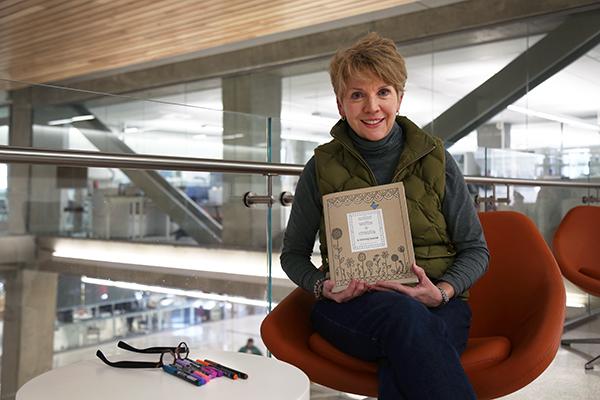Whether you liked to color outside or inside the lines, you probably have fond memories of coloring in coloring books as a child.
But who said you have to stop coloring altogether as an adult? Alumna Trina Lucido, who graduated in 1987 and has worked as a graphic designer most of her life, has created her own version of the adult coloring book.
Lucido added her own spin to a 40-page coloring book by adding lines for writing and calling it a “coloring journal.” The book, called “Color, Write + Create: A Coloring Journal” was released in September 2015. In November, she created a smaller holiday-themed version of the coloring book and this month she has begun selling Valentine’s Day cards for people to color in and personalize.
“Some of the people who would like to keep a journal – they’re afraid of the blank page,” Lucido said. “This kind of gives them a place to start – it’s still their own words, their own artwork as far as how they decide to color it, but I’m not giving a blank page.”
The adult coloring trend has been on the rise this past year, with adult coloring books even topping Amazon’s bestseller list at times. Coloring is also said to be a useful stress reliever, whether you’re six or 60, and the trend has been documented in The New Yorker and The Atlantic. You can even pick up several different versions of adult coloring books – filling in trees or mandalas – at the Foggy Bottom Whole Foods.
Lucido’s pages have themes like beaches and dogs taken from her sketchbooks and wallpaper-esque floral patterns. The journal entry pages match the vibe of the illustration page: The beach page has wavy lines and the dog page has a line that curves to create a path leading from a doghouse to a dog. You can even draw on the cover of the journal, which is made with brown craft paper.
The last page of the journal features an illustration with the words “You are creative” written in block letters. Lucido, who journals every day and regularly cuts and pastes pictures inside her journal, said she ultimately wants this journal to allow everyone to unleash their creative side.
“When I show somebody my journal they say, ‘Oh I wish I were creative’ and it’s like, ‘Well, you are.’ We’re all creative in different ways,” she said. “Inside all of us there’s that little kid that’s like, ‘I want to do something but I can’t,’ and this gives you complete freedom.”
Lucido said she got the inspiration to make coloring books when visiting Paris this spring where she found them in every bookstore.
The enthusiastic response she received when she brought a bunch of the coloring books back home to Virginia gave her the push to start creating her own version. She decided to make her version for adults after hearing about the adult coloring book trend.
Lucido, who majored in mathematics at GW before going on to receive a degree in design from the Corcoran School of Art + Design, said she drew on her love of math and shapes to come up with the some of the recurring motifs for the book.
Lucido created the journal at home over the summer, sketching each design three times and using a lightbox to trace the final version.
“Everything’s hand-drawn, I didn’t use the computer,” she said. “There are some imperfections but that’s what makes them hand-done.”
Lucido said she’s been pleasantly surprised by the reaction to the coloring journals.
“It was kind of a gamble, I didn’t really know how they would do,” she said of deciding to print the first run of 1,000 journals. Since she began selling them in September for $15 each, she’s sold 500.
“Some of the people were buying them for friends who were going through chemo. A friend bought some for her dad who has Alzheimer’s”, she said, adding that parents have bought them for their kids who like to write stories.
Lucido sells the journals through artists flea markets, brick and mortar stores, Amazon and her own website, Jubilee Flea, which also sells art supplies.
Creating this coloring book helped Lucido get over her own lifelong insecurity about her drawing. That insecurity began when she was 10 years old and an art teacher criticized her drawing of a rabbit for not being realistic enough, she said.
“For so long I felt like I’m not an artist because I can’t draw ‒ I can do design, I can do type, I can layout all this but I really can’t draw,” she said. “This helped me after so many years to push past that and the night I was packaging all these up to ship out it was very emotional – like this little girl who can’t draw is shipping out her drawings to the world.”







